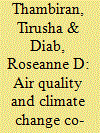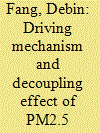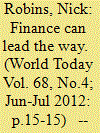|
|
|
Sort Order |
|
|
|
Items / Page
|
|
|
|
|
|
|
| Srl | Item |
| 1 |
ID:
109706


|
|
|
|
|
| Publication |
2011.
|
| Summary/Abstract |
Industries in Durban, South Africa, are a major source of air pollutant emissions and large users of fossil fuel based energy. Durban's energy strategy prioritises energy efficiency at industries as a key action, whilst industries are also the focus of the city's air quality management plan (AQMP). In this paper, measures that have been introduced in industries in Durban to effect air quality improvements and reduce energy consumption are examined in terms of their respective impacts on greenhouse gas (GHG) and air pollutant emissions. It was found that co-benefits for GHG mitigation were achieved when petroleum refineries switched from using heavy fuel oil to refinery gas and methane rich gas. Within other industries, co-benefits for air quality stemmed from reducing fossil fuel energy consumption and the improved efficiency of combustion systems. Air quality and energy policies in the city are being executed independently, without consideration of the trade-offs or synergies of the interventions being implemented. Recommendations are made for authorities and industries to consider the co-benefits for GHG mitigation in their AQMPs and where these are not possible to consider offsetting the increased GHG emissions through improved alignment with energy strategies.
|
|
|
|
|
|
|
|
|
|
|
|
|
|
|
|
| 2 |
ID:
177373


|
|
|
|
|
| Summary/Abstract |
Haze pollution has been a serious environmental issue in China, however, little research has focused on the industrial sector which accounts for a large part of total PM2.5 emissions. This paper aims to disclose the driving mechanism and decoupling effect of industrial PM2.5 emissions. First, this study reveals the spatial-temporal drivers of industrial PM2.5 emissions in China spanning 2000–2014 through geographical detector and logarithmic mean Divisia index decomposition, respectively. Then, the decoupling causal chain of industrial economic growth and PM2.5 emissions is investigated by a refined Laspeyres index method. The empirical results illustrate that: (1) Population distribution is the dominating factor for the spatial heterogeneity of industrial PM2.5 emissions. Different influencing factors show significant synergistic effects. (2) Industrial development effect is the main reason for the increase of industrial PM2.5 emissions, while the reduction in industrial PM2.5 emissions is primarily due to energy intensity effect, followed by coal pollution intensity and energy mix effects. (3) During the study period, the PM2.5-economic growth decoupling undergoes two states, and shows the tendency towards strong decoupling. (4) The PM2.5-coal consumption effect and energy consumption-economic growth effect are important factors influencing the changes of PM2.5-economic growth decoupling indicator, while the impact of the coal consumption-energy consumption effect is quite small. This paper provides important implications for reducing industrial PM2.5 emissions.
|
|
|
|
|
|
|
|
|
|
|
|
|
|
|
|
| 3 |
ID:
123247


|
|
|
| 4 |
ID:
068734


|
|
|
| 5 |
ID:
094891


|
|
|
|
|
| Publication |
2010.
|
| Summary/Abstract |
This study discusses the potential for reducing carbon dioxide (CO2) emissions from energy use by the Brazilian industrial sector in a low-carbon scenario over a horizon until 2030. It evaluates the main mitigation measures, the quantities of this gas avoided and the respective abatement costs. In relation to a benchmark scenario projected for 2030, the reduction of CO2 emissions estimated here can reach 43%, by adopting energy-efficiency measures, materials recycling and cogeneration, shifting from fossil fuels to renewables or less polluting energy sources and eliminating the use of biomass from deforestation. The set of measures studied here would bring emissions reductions of nearly 1.5 billion tCO2 over a period of 20 years (2010-2030). This would require huge investments, but the majority of them would have significant economic return and negative abatement costs. However, in many cases there would be low economic attractiveness and higher abatement costs, thus requiring more effective incentives. Brazil is already carrying out various actions toward the mitigation measures proposed here, but there are still substantial barriers to realize this potential. Therefore, a collective effort from both the public and private sectors is needed for the country to achieve this low-carbon scenario.
|
|
|
|
|
|
|
|
|
|
|
|
|
|
|
|
| 6 |
ID:
121373


|
|
|
|
|
| Publication |
2013.
|
| Summary/Abstract |
This study analyzed the relationship between the CO2 emissions of different industries and economic growth in OECD countries from 1970 to 2005. We tested an environmental Kuznets curve (EKC) hypothesis and found that total CO2 emissions from nine industries show an N-shaped trend instead of an inverted U or monotonic increasing trend with increasing income. The EKC hypothesis for sector-level CO2 emissions was supported in the (1) paper, pulp, and printing industry; (2) wood and wood products industry; and (3) construction industry. We also found that emissions from coal and oil increase with economic growth in the steel and construction industries. In addition, the non-metallic minerals, machinery, and transport equipment industries tend to have increased emissions from oil and electricity with economic growth. Finally, the EKC turning point and the relationship between GDP per capita and sectoral CO2 emissions differ among industries according to the fuel type used. Therefore, environmental policies for CO2 reduction must consider these differences in industrial characteristics.
|
|
|
|
|
|
|
|
|
|
|
|
|
|
|
|
|
|
|
|
|